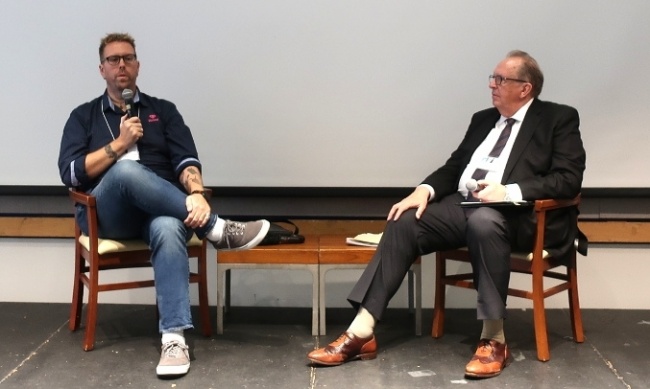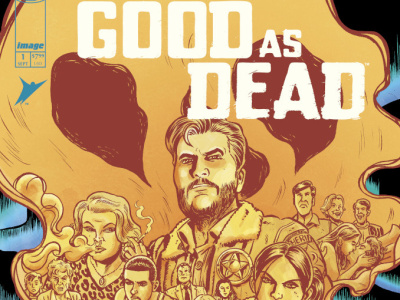At one point during the Q&A, someone in the audience asked Powell to estimate what was the maximum percentage of periodical sales sustainable for a comic shop, given the lower margins and non-returnability of single-issue comics. The questioner threw out the number of 65% as a benchmark.
Comics have issues. Are they getting worse? I think it took people a minute to understand what was actually being asked here. Essentially, it’s become a losing strategy for comic stores to sell too many new comic books – at least relative to other merchandise like toys, apparel, collectible back issues (for those stores that still carry them) and particularly graphic novels, almost all of which ring up at a higher unit cost at the register. The question is no longer about whether that trend can be reversed, but rather at what level does reliance on (primarily DC and Marvel) periodical sales (50%? 65%? 70%?) start becoming fatal to the business?
This is unlikely to be news to the many retailers around the country who have been updating their stores, changing their merchandise mix, and welcoming the changing fanbase because they can see which way the wind is blowing. But it was bracing to hear it spelled out in such stark terms by the proverbial weatherman.
It’s especially interesting since comic sales at the top line are doing fine: up slightly year over year from 2017 to 2018, with Marvel doing a little better than DC. Rents and minimum wages are going up in many urban locales, eating into profits, but that’s secular to all storefront retail, not just comic shops. Yet somehow, the traditional business of selling monthly superhero comics to reliable, habitual customers in the usual quantities is not, by itself, enough to keep the doors open.
Powell: Diversification is essential. I followed up with Powell via email to make sure I understood the question and his response properly. Here’s part of what he had to say:
POWELL: It’s tricky to answer these, as it was in the room, because there are so many differences in business models, locations, etc.
Leaving out businesses with a strong pre-order / mail order / eBay component, as those can skew the information, a store relying heavily on periodical sales must be particularly diligent in their ordering. The actual margins on periodicals aren’t bad, but they "age" differently from most other products. If a store over-orders, then unsold copies can quickly eat into the profits from sold copies. That’s why many periodical-heavy stores rely on preorders and subscriptions more than other stores, as those give them "guaranteed" sales and data to inform their ordering.
With creator and content changes, even that preorder data can be problematic if the changes aren’t caught at FOC [final order cutoff] and orders adjusted up or down. Some publishers’ focus on variant covers and other incentives further skew those numbers, so stores must be even more careful when ordering the subsequent issues to take into account factors that may have affected sales (or orders) of the prior issues.
When we talk about a periodical-heavy store, we’re almost always looking at stores whose sales are heavily concentrated with a few publishers, so a downturn in sales due to editorial changes could leave a store looking for replacement income on short notice. An example of this was Image & Robert Kirkman’s The Walking Dead, which surprised many retailers when it came to an end. Many stores were moving an impressive number of the books each month, and it was a consistent seller with reliable numbers. Its end left retailers with a gap in their sales that some weren’t prepared for.
Again, no news here for experienced retailers. I can’t imagine there are many stores left standing that don’t know how to order, how to gauge the tastes of their customers, and how to roll with the (frequent) punches in terms of publisher-driven surprises. This leads to risk-aversion on the part of retailers, making it harder for customers to find new stuff on the shelves if retailers haven’t ordered it, but that’s also not a new problem.
Relative to the imperative to diversify, Powell goes on to write:
Specialty retail is like most other businesses, even when it looks different. The broader selection a store offers, the more value they offer to consumers and the wider net they cast for their customer base. A broad base helps weather changes, and also brings in more people to whom they can hand-sell books. That’s good for comics as an industry, as there are still a great many people who don’t know about the many great things there are to discover on our shelves.
True enough, and many of the more traditional retailers would do well to listen to this advice before it’s too late. The math here is pretty clear. Marvel and DC, while holding steady in absolute terms, dominate a shrinking market (superheroes), a shrinking format (periodicals) and a shrinking channel (direct market) relative to the growth that is taking place in genres like kids comics and manga, whose popularity is driving sales of graphic novels in the trade book market.
Change is gonna come. In fairness, Diamond can’t be expected to have all the answers here. The distributor margin is even lower than the retailer margin, and the costs of servicing the direct market are high. And while Diamond is the single source for non-returnable periodical comics, comic shops do have other options when it comes to ordering trade books if they are willing to accept the lower margins on returnable inventory.
What’s troubling about this conversation is that it’s taking place during relatively good times. Despite the headwinds facing retail, the U.S. economy in general is in pretty good shape. Comic sales in general have risen significantly since the recession of 2010-11, even if that growth has been concentrated in certain segments and stagnant in others.
Sooner or later, we’re going to hit another downturn, and at that point, business models that have been barely holding on through the good times will start to go rotten in a hurry. Is 65% reliance on periodical sales too high? Is 50%? Or less?
The best time to answer that question was nine months ago. The next-best time to answer it is now.
The opinions expressed in this column are solely those of the writer, and do not necessarily reflect the views of the editorial staff of ICv2.com.
Rob Salkowitz (@robsalk) is the author of Comic-Con and the Business of Pop Culture.









